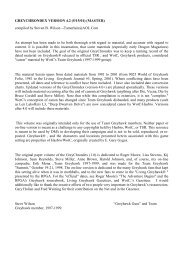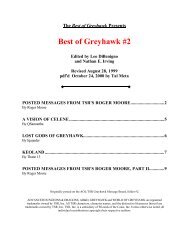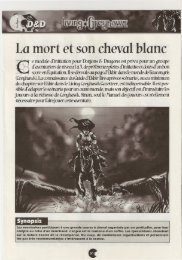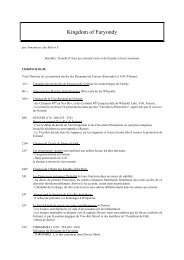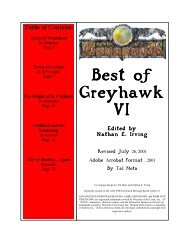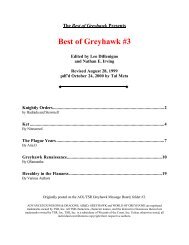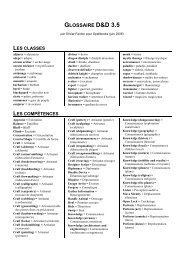Best of Greyhawk VII - Le Monde de Greyhawk
Best of Greyhawk VII - Le Monde de Greyhawk
Best of Greyhawk VII - Le Monde de Greyhawk
- No tags were found...
Create successful ePaper yourself
Turn your PDF publications into a flip-book with our unique Google optimized e-Paper software.
this report assumes a certain familiarity on Dey Hasm's part with the cultists, but he also clearly refers to the cultlea<strong>de</strong>r by using a word which approximates in Common to "the masculine priestess." Whether this means that theTelchite ruler was a masculine woman, or a man in the garb <strong>of</strong> a priestess is unclear, but either way, a case may bema<strong>de</strong> for feminine origins <strong>of</strong> the cult. Similarly, some <strong>of</strong> the artifacts discovered by civilized Baklunish along thenorthern sea coasts have inclu<strong>de</strong>d gol<strong>de</strong>n jewelry previously associated with the cults <strong>of</strong> Wenta and Sotillion, and<strong>de</strong>rived from ancient feminine adornment favored by Oeridian priestesses. It is unfortunate that the ravaging Chakyiktribes have <strong>de</strong>stroyed so many sites <strong>of</strong> former Telchite worship.MythThe creation stories <strong>of</strong> the ancient Oeridians have diverged and reconverged so many times that it isimpossible to say which is true, or even which is first. What is known in the case <strong>of</strong> the mystery cults is that theoracular practices stem from the cult <strong>of</strong> Ehlonna the Eternal Huntress, and that the uniform secrecy and mysteryassociated with the cults <strong>of</strong> Ehlonna and the Four Winds suggests that the cults are linked at some point in the past.Here we reach one <strong>of</strong> the most vexing problems <strong>of</strong> scholarship, in that there are two distinct myths involvingthe creation <strong>of</strong> the Four Winds and their cults. The myths are the Ehlonnic and the Procean, and it is worthwhile toour discussion to examine them both here rather than make a choice between them.The Ehlonnic myth is not available to us in full <strong>de</strong>tail, but from what is known, we can conclu<strong>de</strong> that thereexisted a sort <strong>of</strong> sisterhood <strong>of</strong> god<strong>de</strong>sses (the myth makes no allowance for the masculine gen<strong>de</strong>r <strong>of</strong> Telchur) andthat these sisters met in secret places to share information and to <strong>de</strong>termine the <strong>de</strong>stiny <strong>of</strong> mortals, nature, and theseasons. This latter part seems to square with the Ashtis cult's similarities to the Baklunish Istus, since it is believedthat the Ehlonnics emerged from the universal faith <strong>of</strong> Ashtis. The nature <strong>of</strong> the sister-god<strong>de</strong>sses' meetings isunknown, but it is wi<strong>de</strong>ly agreed that they were more pragmatic than the patriarchal cults, concerned more with thewell-being and comfort <strong>of</strong> their followers than with power and the domination <strong>of</strong> other cults. In the face <strong>of</strong> emergentcults such as the Zilchites, the Proceans, and the later Pholtics, it is no surprise that the mystery cults kept to hid<strong>de</strong>nplaces.The Procean myth is pantheistic in nature (and is, in fact, among the earliest pantheistic stories to emergefrom Oeridian culture), and speaks <strong>of</strong> the fathering <strong>of</strong> the Four Winds upon Ehlonna the Huntress by Procan. In thismyth, Ehlonna has been chosen to wife by Velnius Skyfather, and while the weather god is away creating a storm,Procan comes to Ehlonna and the two share a moment <strong>of</strong> intimacy which leads to the births <strong>of</strong> the Four Winds,Altroa, Wenta, Sotillion, and Telchur. Fearful for her children's safety, Ehlonna disguises them all as young suppliantpriestesses <strong>of</strong> her faith and thus avoids Velnius' suspicion. This works for many years, until Telchur, upon coming <strong>of</strong>age, rebels against his mother, ashamed perhaps at having grown up as a girl. He betrays his mother and sisters toVelnius on the condition that he be spared the weather god's wrath. Velnius rampages, hurling his children to thefour corners <strong>of</strong> Oerth. Despite his promise, he even seeks out Telchur, who avoids him by hiding in a cave <strong>of</strong> ice andcovering himself with snow. This, say the Proceans, is why the North Wind is alway so cold and why it blows onlybitter tidings to nature, causing the flora and fauna to hi<strong>de</strong>.The Procean myth mirrors the <strong>de</strong>velpment <strong>of</strong> the Oeridian pantheon in a number <strong>of</strong> ways. The cult <strong>of</strong>Velnius did in fact drop in importance, losing many <strong>of</strong> its worshippers to <strong>de</strong>fection to other cults. The priests <strong>of</strong>Procan may have circulated the above myth in or<strong>de</strong>r to accomplish two ends. First, they reduced Velnius to thestatus <strong>of</strong> a cuckol<strong>de</strong>d tyrant and thus un<strong>de</strong>rcut his following. Second, by linking their cult with that <strong>of</strong> the Ehlonnics,they may have sought to lay claim to the Ehlonnic faith, adding it and intertwining it with their own. Judging from thecurrent state <strong>of</strong> the Oeridian pantheon, they seem to have been largely successful.HistoryAlthough much <strong>of</strong> what took place in the formative stages <strong>of</strong> the Oeridian pantheon is shrou<strong>de</strong>d in mysteryand misun<strong>de</strong>rstanding, the rise <strong>of</strong> the Zilchites, with their surprisingly advanced written language, has given us someclues. We can look at such works as the Fivefold Scroll <strong>of</strong> Thenix, and obtain some insights. However, it should berecalled that the Zilchites were cultists in their own right, and a certain bias on the part <strong>of</strong> Zilchite historians may bepresupposed. Also, the old adage that "history is written by the victor" <strong>de</strong>serves some credit in this case.For the purposes <strong>of</strong> our discussion, we have chosen to examine Phenophelos' _Migrations <strong>of</strong> the OeridianPeople_. In his earliest chapters, he makes reference to ol<strong>de</strong>r texts now lost to us, so what he says cannot beconfirmed firsthand, though it is compelling in light <strong>of</strong> what we have already discussed.Although Phenophelos does not <strong>de</strong>scribe the rise <strong>of</strong> the mystery cults, he does give us some insight intotheir dispersal. Most remarkably, he treats on the conflict between the Ehlonnics <strong>of</strong> Queen Tserxis and the Velniangeneral <strong>Le</strong>ops <strong>of</strong> Keraks. Tserxis's people occupied the lower valley just north <strong>of</strong> the Crystalmists, and wereapparently famed for producing healthy goats and for growing herbs and vegetables which were at once more



